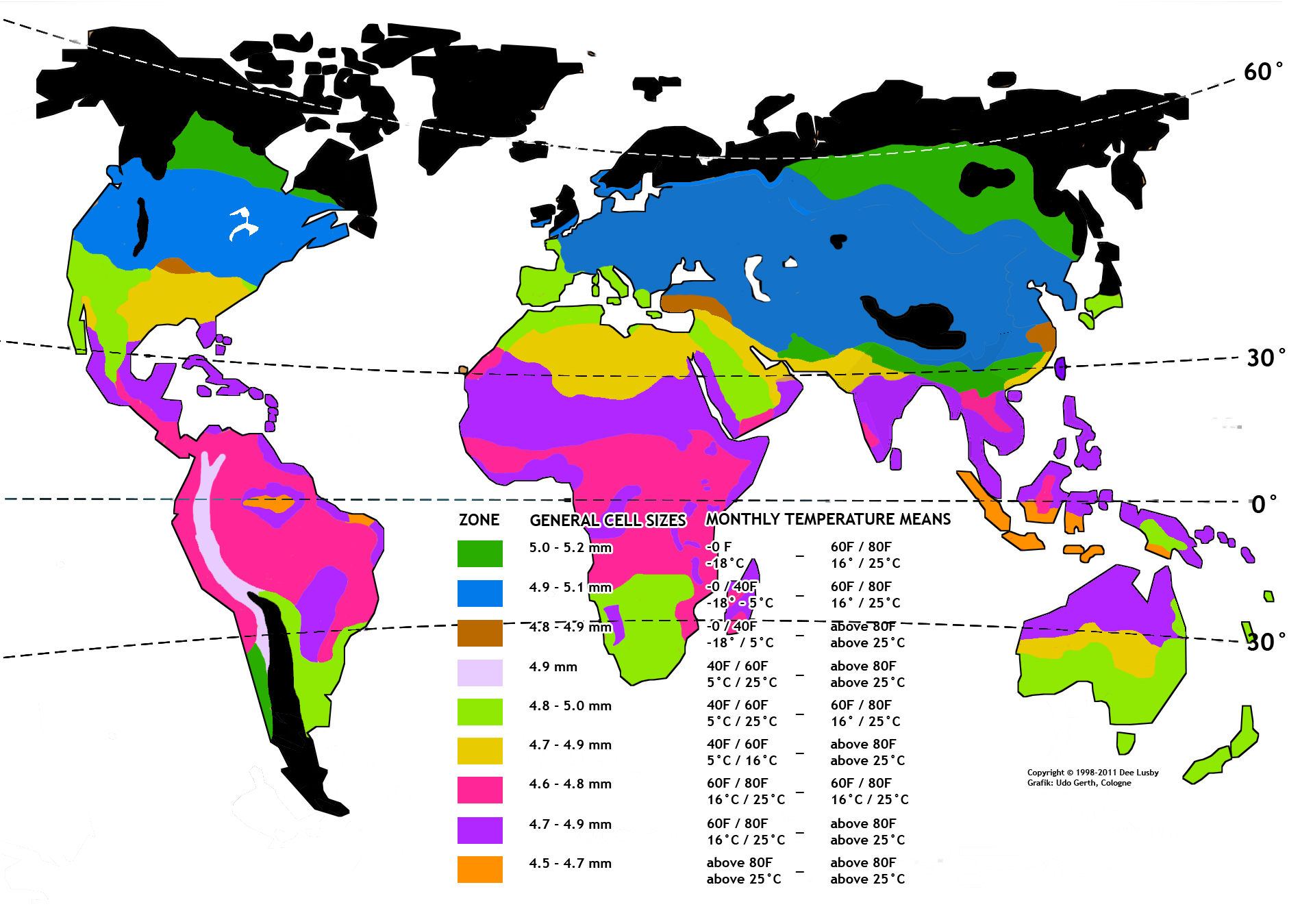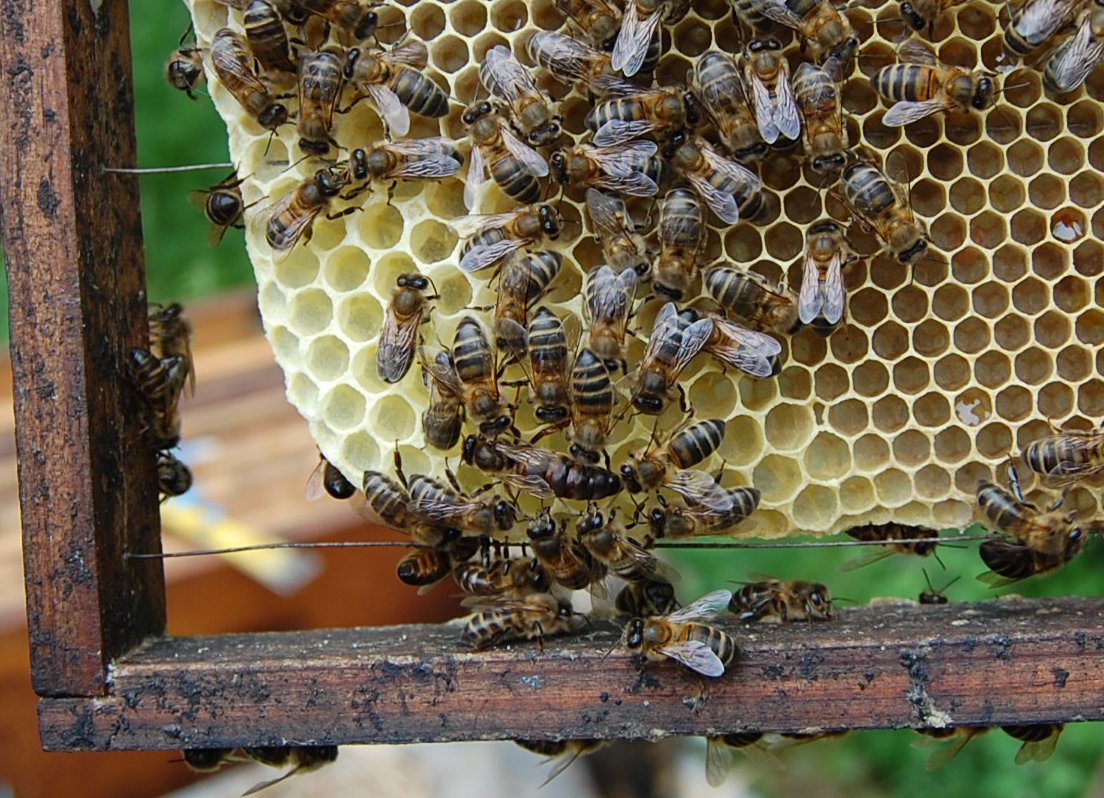Cell size
Who is telling us if the cell size impressed on the foundations is what the bees need?
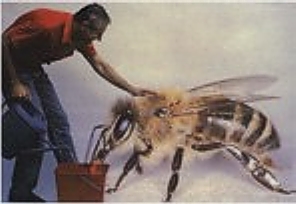
Dee Lusby discovered, after intensively studying beekeeping literature (from over 100 years and more), the cell size commonly used does not match the bees' needs.
And yet the cell size is a critical factor. I’d even say the bee can’t live in harmony with nature without the right size. The Belgian professor Baudoux stated about 100 years ago "large cells, large bees, lots of honey" He experimented with extreme sizes, large and small, and incredibly, no one knows why, the cell size on all foundations remained at about 5.4 mm to this very day.
It looks like the bee gets to its natural balance on a cell size from 4.9 mm downwards. At 4.9 mm, and the distance between the combs reduced to 32 mm, the temperature in the nest rises, reducing one day of the incubation period. At 20 instead of 21 days, the bees outrun the Varroa.
The Varroa mite is of course aware of that, therefore in the summer it only breeds within the drone brood, as they can’t multiply within the worker brood. The Asian ‘cerana’ and African bees, without varroa problems, build small cells.
here is a map of the cellsizes 100 years ago - click on the map to see it bigger
Observations of Michael Bush
Pre and Post Capping Times and Varroa
8 hours shorter capping time halves the number of Varroa infesting a brood cell.
8 hours shorter post capping time halves the number of offspring of a Varroa in the brood cell.
Accepted days for capping and post-capping, (based on observing bees on 5.4 mm comb)
Capped 9 days after egg laid
Emerges 21 days after egg laid
very important: reducing of comb distance to 32mm
Another point is that small cell bees have a much longer life span, from 8 up to 12 weeks. The conventional large cell bees only have a lifespan of 6 weeks, which is considerably reduced by the use of chemicals, like anti Varroa treatments (Fernando Clatayud, biologist, Valencia, spain). This longer lifespan produces incredibly strong colonies as the work inside of the colony can be done by a lot more bees, which is a prerequisite for a healthy immune system. Ongoing stress by the same amount of work to be done by too few bees negatively affects the bee’s immune system.
Dee Lusby found out that the cellsize of 4.9mm is the actual fundamental prerequisite, that the hygienic behaviour VSH appears, which means the active culling of Varoa mites from the infected brood cells. see hygienic behaviour VSH
With this the topic addressed, there is still much more to be explained. The cell size is only one aspect amongst many that must be changed to get resistant bees.
The history of cell sizes (Dee Lusby)
- The first artificial comb foundation was made in Germany in 1842 by Gottlieb Kretchmer.
- I would say our present era of problems began around 1891 in Belgium with the introduction of artificial comb foundation with 920 cells to the square decimeter which would equate to about midway between 4.6 cm and 4.7cm for 10 worker cells.
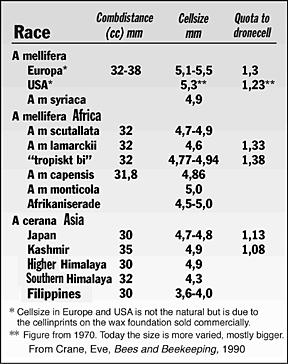 |
| cell sizes of different bee races (in europe and USA too big due to use of too big cellprints) |
A Prof U. Baudoux of Belgium published an article in Progress Apicole in June, 1893, advocating the use of larger comb cells, as a result of experiments duly described. It seems Prof Baudoux wanted to rear bees of extraordinary vigor, able to forage over a more extended flight-radius and to visit a multitude of flowers the nectar of which was, then (and probably still is), out-of-reach of their tongues.
He experimented with cells up to the limit of 750 cells per square decimeter, the sizes of cells which he obtained by stretching wax comb foundation. Then encouraged by his experiences, he wished to do still better—”TO GO TO THE BOUNDS OF POSSIBILITY”. (Here is where our current modern-day problems begin with parasitic mites and their secondary diseases.)
Prof Baudoux experimented with various sizes of foundation per the square decimeter, namely: 750, 740, 730, 710 and down to 675. He also experimented with various ways of measuring cells and devised his own measurement system for it. (Unfortunately, there was no corresponding correlation chart made for his devised measurement system, vs. the traditional way of measuring comb foundation that had been in use for over 2,000 years back to before the time of Christ, so beekeepers could go back and forth between the two measurement systems.)
Prof Baudoux was so successful with his writing and his experiments, and so convincing , that manufacturing houses all started selling foundation with enlarged cells and claiming good results for the use of the same. Most of this work was done around the late 1920s through the 1930s and 1940s. (The result has been that this process of bigger is better with its resultant selling has never stopped, and continues up to modern day to the detriment now, that only enlarged oversized foundations (well beyond the bounds of possibility for bigger honeybees as envisioned by Prof Baudoux) are now only sold and standardized large at that, i.e. 5.7cm for 10 worker cells being about the largest).
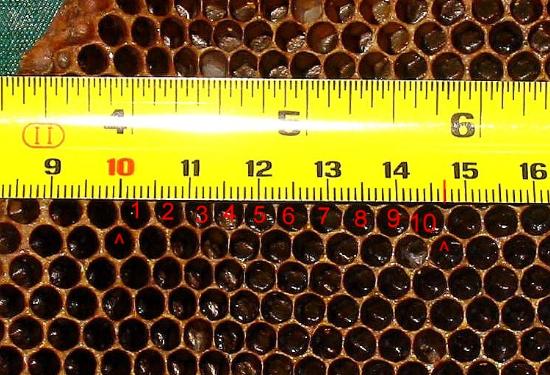
How do we measure cell size?
The default is to measure 10 cells from wall center to wall center and then divide by 10.
Dee Lusby:
I would say our present era of problems began around 1891 in Belgium with the introduction of artificial comb foundation with 920 cells to the square decimeter which would equate to about midway between 4.6 cm and 4.7cm for 10 worker cells. The beekeepers there all adopted this size of cell. The experts of that time believed that it was advantageous to produce as many bees as possible on the least possible surface of comb. Thus there was said to be a premature narrowing of the cells throughout Belgium, and at the end of a few years the bees were miserable specimens. (We could say that this was then the opposite of today’s problem of bigger is better.)
It was then that to combat so harmful a tendency that an idea was born with a proposed magnificent final (which we are still playing out today). A Prof U. Baudoux of Belgium published an article in Progress Apicole in June, 1893, advocating the use of larger comb cells, as a result of experiments duly described. It seems Prof Baudoux wanted to rear bees of extraordinary vigor, able to forage over a more extended flight-radius and to visit a multitude of flowers the nectar of which was, then (and probably still is), out-of-reach of their tongues.
He experimented with cells up to the limit of 750 cells per square decimeter, the sizes of cells which he obtained by stretching wax comb foundation. Then encouraged by his experiences, he wished to do still better—”TO GO TO THE BOUNDS OF POSSIBILITY”. (Here is where our current modern-day problems begin with parasitic mites and their secondary diseases.)
Prof Baudoux experimented with various sizes of foundation per the square decimeter, namely: 750, 740, 730, 710 and down to 675. He also experimented with various ways of measuring cells and devised his own measurement system for it.
Unfortunately, there was no corresponding correlation chart made for his devised measurement system, vs. the traditional way of measuring comb foundation that had been in use for over 2,000 years back to before the time of Christ, so beekeepers could go back and forth between the two measurement systems.
a fatal mistake
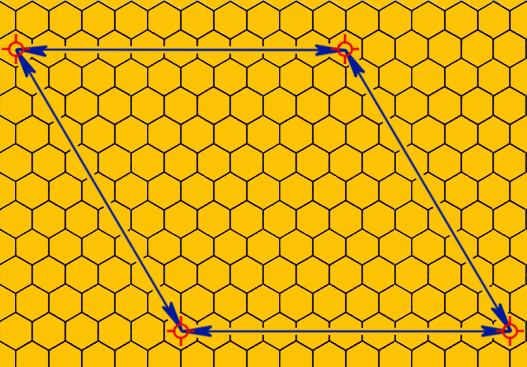 |
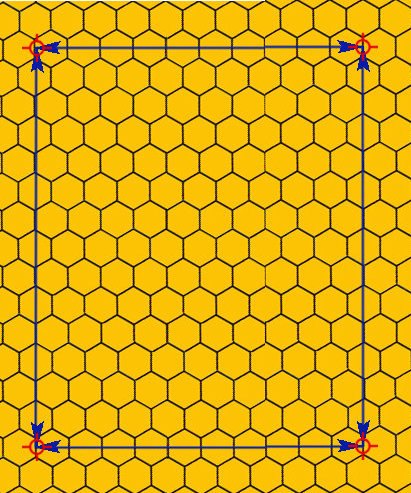 |
| old rhomb metod to measure: | new metod from Baudoux on |
a fatal mistake
The old method of measuring results in much fewer cells per dm² as the new one introduced by Baudoux. Before Baudoux foundations with about 5 cells per inch were used, which corresponds to about 800 - 830 cells per dm ² according to the old measurement at 5.0 to 4.9 mm. But there was no conversion system and foundation manufacturers , after Baudoux, in the 20s till the 40s, took over the rate of 800 cells/dm ², but applied the new method of measuring. Thus it came to a cell sizes of about 5.4 mm. And apparently no one is aware of this serious error, because the size is maintained to the present day.
conversion table of the different measuring metods:
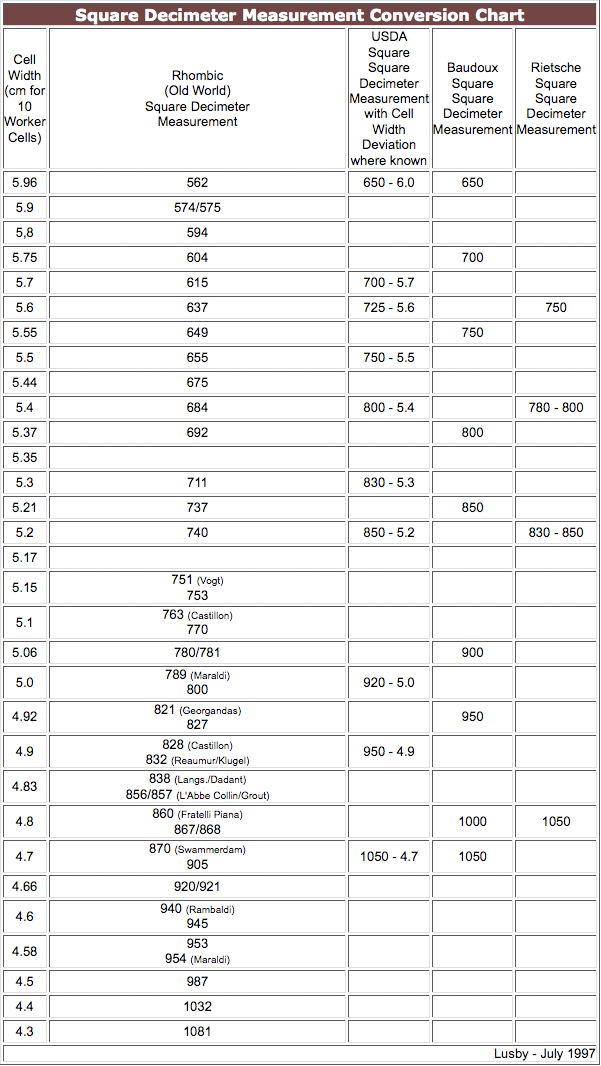
Dee Lusby:
Prof Baudoux was so successful with his writing and his experiments, and so convincing , that manufacturing houses all started selling foundation with enlarged cells and claiming good results for the use of the same. Most of this work was done around the late 1920s through the 1930s and 1940s. (The result has been that this process of bigger is better with its resultant selling has never stopped, and continues up to modern day to the detriment now, that only enlarged oversized foundations (well beyond the bounds of possibility for bigger honeybees as envisioned by Prof Baudoux) are now only sold and standardized large at that, i.e. 5.7cm for 10 worker cells being about the largest).
Could this continuing trend towards bigger is better be an underlying causative effect creating todays problems of parasitic mites and their accompanying secondary diseases? Probably. But on what evidence would one place such a thought?
Unfortunately for us all, it was not the large cell in itself for which Prof Baudaoux was working, but rather instead for the selection of a better bee. IT IS IMPORTANT FOR TODAY’S BEEKEEPERS TO REMEMBER THE TIME FRAME HERE, AND ITS PLACE IN HISTORY, AND ALSO THE FACT THAT THE MEASUREMENT SYSTEM DEVISED BY PROF BAUDOUX WAS NOT CORRELATED WITH TRADITIONAL MEASUREMENT METHODS. WHY? BECAUSE, AN UNDERLYING CAUSATIVE EFFECT FOR TODAY’S PARASITIC MITE PROBLEMS AND THEIR ACCOMPANYING SECONDARY DISEASES WAS BORN HERE!
Equally unfortunate for us all is the fact that Prof Baudoux was a follower of what is called Lamarckian Theory, and believed that it was possible to improve the honeybee permanently, by giving her the chance to grow larger in each succeeding generation. However, to a follower of Darwinian or Mendelian theory, this is indeed a very uncertain doctrine; and the bees themselves appear to confirm this criticism (even today any beekeeper can compare the feral to those bees confined domestically), since even back in the early 1900s it was common knowledge that they tend to retrogress in the size of the worker comb cells they build when let alone, back to what is NATURAL as put forth by the laws of Nature and not by man’s artificially created and politicized rules.
|
Dee Lusby:We have found through reading, that mills have been made in many sizes over the years, all the way up to 3-1/2 cells to the inch. THIS IS WHERE OUR INDUSTRY HAS GOTTEN INTO SO MUCH TROUBLE. CELL SIZES, THEIR SIZE, AND HOW TO MEASURE THEM. Most beekeepers universally agree that five cells to the inch is worker size and four cells to the inch is drone size in the feral population. But, the domestic sizes our bees today have ended up on, are quite different and have wrought havoc, as artificial combs have gotten bigger. The stress upon our honeybees caused by being out-of-balance with natural flora has opened Pandora’s box to foulbrood diseases, chalk, and viral infections. By being too big, our domesticated honeybees have taken on parasitic mite infestations as our now pseudo-drones, aka: worker bees, are perceived as a new food source by both Varroa and Tracheal mites. With all this damage being done, we find no teaching anywhere on the history of use of artificial comb foundation sizes in the USA, so our beekeepers can make rational decisions concerning proper usage.
The various comb cell sizes (706, 711, standard, drone, etc) were originally designed with meaning, which is now forgotten in today’s modern world. No one person or company is to blame in the USA or elsewhere in our world for artificially increasing honeybees so big as to cause disease and parasitic mite problems that now encompass over 135 nations at catastrophic level, placing them in a situation out-of-tune with the reality of Nature. Nothing was hidden and everything was written and published out in the open.
The only thing that has happened is that artificial supposition and an artificial domesticated system of beekeeping has so far prevailed over that found naturally occurring in Nature and has been taught.
It began with a simple idea everyone wanted to participate in, i.e. scientists, manufacturing houses. Now through the passing of each successive generation (figure 20 years to each new generation), the growing disparity of size between feral and domestic hives dictates this bigger-is-better trend must be corrected and its underlying causative effects must be brought to light and taught, if beekeeping as we know it is to continue.
In Belgium, Prof Baudoux measured workers in the range of 5mm to 5.17mm and 5.35mm per cell. (Ordinary drone cells he placed at 5.5mm next to 5mm for worker cells.) Even he found 5.5mm drone cells next to 5mm worker cells to be double in volume of cell contents for food confirming Mullenhoff’s results. When we then consider having today, foundation on the market as large as 5.7mm, it’s not hard to see how it would not be disastrous for beekeepers to use, because of parasitic mite attraction with a pseudo-effect on worker bees perceived as a food source just like that of drones.
Yet, look how much foundation on today’s market is 5.44mm in size (close to the 5.5mm drone size measured by Baudoux).
Wouldn’t this too, also be dangerous for attraction for parasitic mites, causing a pseudo-effect, with mites mistaking worker bees for drones?
JUST HOW BIG THEN, IS TOO BIG?
I would say too big is when a colony of bees starts to become distressed, which leads to stress, which leads to disease, which lets a beekeeper know through visual perception that something is wrong within the hive.

